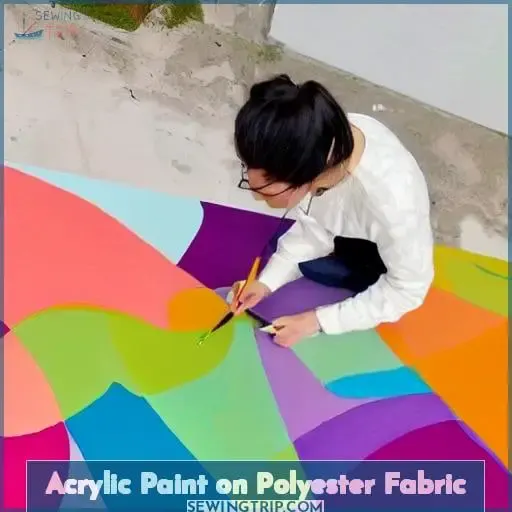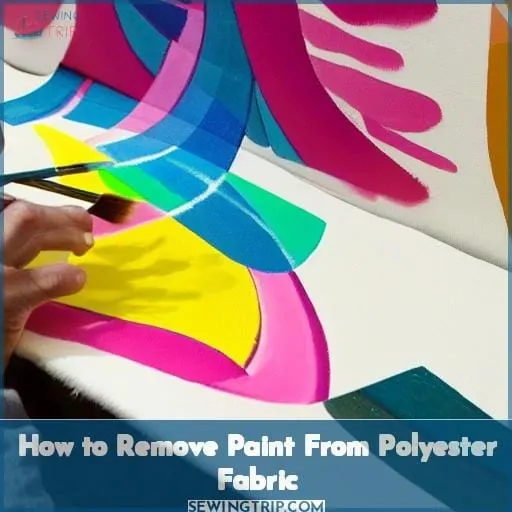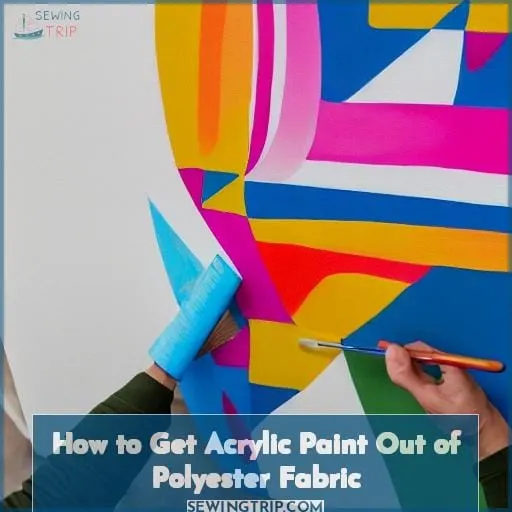This site is supported by our readers. We may earn a commission, at no cost to you, if you purchase through links.
You can make your polyester fabric look brand new with a fresh coat of paint! Acrylic paints are just what you need to create stunning works of art on this versatile material. With the right supplies and techniques, painting on polyester is easier than you think.
Revitalize an old shirt or add a splash of color to any piece – give it that extra bit of personality that will take your style from good to great. Whether you’re looking for vibrant colors or subtle hues, read on for more information about how to paint polyester fabric like a professional!
Table Of Contents
- Can You Paint on Polyester?
- Does Paint Stick to Polyester?
- What Kind of Paint Do You Use on Polyester?
- Does Fabric Paint Work on Polyester?
- Best Fabric Paint for Polyester
- Acrylic Paint on Polyester Fabric
- How to Paint Polyester Fabric
- How to Spray Paint Polyester Fabric
- How to Remove Paint From Polyester Fabric
- How to Get Acrylic Paint Out of Polyester Fabric
- How to Get Latex Paint Out of Polyester Fabric
- Frequently Asked Questions (FAQs)
- Conclusion
Can You Paint on Polyester?

Yes, you can easily give your polyester fabric a new look with just a few tools and some creativity! Acrylic paint is the right type of paint to use on polyester. It’s thick consistency allows it to stick well and its versatility makes it adaptable for various surfaces. To ensure that the project lasts longer, be sure to use a fabric medium or acrylic medium with the acrylic paint as these products are designed specifically for fabrics such as polyester.
Furthermore, sealing your painted design will help protect against outside damage while also providing either an attractive glossy or matte finish depending on what kind of sealer you choose.
Additionally, oil-based acrylic paints are great options when dying fabrics like polyester shirts since they don’t fade quickly compared to other types of dyes or paints which may stain instead of coloring more evenly over time without fading away too soon. Therefore using this combination ensures that not only will your painting last longer but also retain its vibrancy even after multiple washes if sealed correctly!
Does Paint Stick to Polyester?
Yes, you can create beautiful designs on polyester fabric with an acrylic medium, as long as you prepare the material properly and apply it evenly. Acrylic paint sticks well to polyester when used in combination with a fabric medium or sealer. Dyeing the fabric before painting will help ensure that your colors remain vibrant and true after drying.
For best results, use puff acrylic paints for textured effects or regular craft-grade acrylics for smooth surfaces like shirts or canvas bags. To avoid smudging during application, make sure to prime your project surface first using a specialized adhesive designed specifically for polyester fabrics such as Aleene’s PolyTack Adhesive Spray or Beacon Fabri-Tac Permanent Adhesive, which work great on most apparel applications and crafts projects alike.
Choosing the right brushes is critical if you want perfect lines free from any stray hairs; synthetic bristles are best suited for paint-stained fabrics like this one since they don’t absorb too much of pigment while still giving excellent coverage power!
What Kind of Paint Do You Use on Polyester?
Painting polyester fabric can be fun and creative. Acrylic paint is the best option. Use it on its own, pair it with fabric medium for stronger adhesion, or use puff acrylic for 3D effects. Specialized fabric paints and spray paints are also available.
It’s a great way to customize clothing or accessories.
Acrylic Paint
You can create stunning designs on fabric with acrylic paint, taking your projects to the next level. Before painting polyester fabrics, prepare the surface by cleaning with soap and water. For best results, use a good quality acrylic paint and avoid dark colors that might bleed. To apply the paint evenly, use different application methods: brush or sponge for thin coats, spray paint for larger surfaces. Allow drying time between coats and heat setting techniques before washing off any residue from supplies used in preparation or during painting. These tips will help ensure a successful project that stands up to wear over time. Enjoy your work!
Fabric Paint
If you’re looking to add some extra flair to your fabric project, consider using fabric paint! Pre-wash the fabric and make sure it’s dry before painting polyester fabrics with acrylic paints. Mix a fabric medium in with the acrylic paint to make sure the paint sticks well and lasts longer.
There are a variety of ways to apply this type of paint; brushes and sponges for detailed designs, freehand creations, spray cans of different colors if bleaching isn’t an option, and airbrushing for more subtle shading effects. Don’t use fabric softeners when washing painted fabrics – they can cause fading and discoloration over time.
Heat setting helps seal in the pigment, but always follow manufacturer’s instructions about curing times before wearing finished projects. Pre-washing materials before dying them and using quality materials like textile mediums or spray paints will give better results than just applying multiple coats without these components.
Be careful when spraying near other objects, as aerosols travel further than expected. Allow enough drying time between each coat so the pigments stick properly, or additional coats won’t do much good if the previous layer hasn’t dried yet!
Puff Acrylic Paint
Add a unique touch to your project with Puff Acrylic Paint. Its quick-drying formula allows it to stay put on polyester fabric, giving you the perfect retro look in no time!
Use paintbrush techniques and stencil designs for clear, professional-looking designs. To make sure the color stays vibrant, mix it with a little water or fabric protection medium before application.
When painting clothing made of polyester, prewash them first then add some textile medium or acrylic medium. Polyester is stretchable, so it needs full coverage from paint.
Seal off any painted areas so they’ll last longer. Use an aerosol sealer or brush-on varnish when finished.
With these tips and tricks, you’ll have beautiful results every time when learning how to paint polyester fabric!
Spray Paint
For a fast and easy finish, try using spray paint to quickly revamp your polyester project! Synthetic brushes are best for spraying fabric; they won’t leave bristles behind. Look for spray paints specifically designed for use on fabric or textiles. These provide better results than standard spray paints.
Advantages of this type of paint:
- Dries quickly
- Provides even coverage over large areas
- Won’t cause stretching or shrinking.
Follow manufacturer instructions for prepping surfaces before painting. Allow adequate drying times between coats if necessary.
If mistakes occur during application, wait until dry then remove with a cloth soaked in water and mild detergent. Don’t rub too hard as this may damage fabric fibers.
Does Fabric Paint Work on Polyester?
You can use fabric paint to create stunning designs on polyester, giving it a unique and eye-catching look. Fabric paints are specifically designed for fabrics like polyester, so they’ll adhere better than regular acrylic or oil-based paints.
When priming the fabric, use tape or painter’s tape around your design area if using larger stencils. This will help ensure an even application of paint that won’t stretch out the material too much as you work with it. Take care not to stretch it too much while painting. This is especially important with designs made up of small shapes close together, as stretching could cause them to lose their shape when they cool down after heat setting.
Make sure any areas along seams and bends in the fabric have enough coverage from paint by adding a little thinner during application. These areas tend to be where most fading occurs due to movement over time.
Finally, remember sealant is always a good idea! After applying multiple coats of color, finish off with either Liquitex Professional Effects Medium (for water-based) or Liquitex BASICS Gloss Varnish (for oil-based). These items can be found in craft stores, online retailers like Amazon, and local brick & mortar stores like Michael’s Arts & Crafts store. You can also find them in some specialty art supply stores and fabric shops, so check those places first since prices may vary.
Best Fabric Paint for Polyester
If you’re looking for the best fabric paint to use on polyester, Tulip Fabric Paint, Jacquard Fabric Paint, and Dye-na-flow are all great options. Tulip offers a wide range of colors with a matte finish that can be heat set for permanent results.
Jacquard’s vibrant pigments provide good coverage and their paints have an opaque finish when dry.
Dye-na-flow is designed specifically for fabrics and produces beautiful sheer shades that won’t crack or peel over time.
Tulip Fabric Paint
With Tulip fabric paint, you can add a pop of color to any polyester item and bring it to life with creative designs. Before getting started, proper preparation is essential for painting success. Make sure the fabric is clean and dry. Wear gloves or use a respirator mask when handling materials like acrylic paint or sealant products to protect your health from fumes or prolonged contact.
Mix colors needed for your project in a bowl until fully blended. Add any last additives such as mediums or topcoats.
Follow instructions on how to apply each product onto the surface of choice – brush strokes along canvas pieces or spray-painting shirts. Allow drying time according to manufacturer guidelines. Some may require heat setting while others don’t.
Use stain resistant techniques afterwards if desired to keep projects vibrant longer without fading.
Jacquard Fabric Paint
Experience the vibrant look of Jacquard fabric paint to turn any polyester item into a work of art. With these painting techniques, you can create unique designs that’ll last for years with proper care. The drying time is quick so you can enjoy your artwork right away! There are many colour options, and non-latex fabrics are available for those with allergies or sensitive skin.
Before starting, have everything ready: bowls with a little moisture; laundry detergent, if required; brushes; and regular cleaning tools like rags and paper towels.
Mix the paint – once mixed it cannot be stored. Pre-wash, if needed. Apply the paint to the item. After 24 hours, use a sealant or topcoat and heat-set with an iron. Now you can enjoy your one-of-a-kind creation!
Dye-na-flow
Transform your polyester fabric into a beautiful work of art with Dye-na-flow. Quick drying time and vibrant colors make stunning designs that’ll last for years. Whether you’re looking for intricate works or simple patterns, it’s the perfect choice for painting hobby fabrics.
Before starting any project, fabric preparation is key. Pre-wash the material and make sure it’s completely dry before stretching it out on a flat surface. To ensure an even dyeing process and avoid mistakes, use large bowls with wide openings so all areas get painted properly.
When making artwork, use techniques like layering and blending while applying paint onto fabric for best results. Protect finished designs from outside damage by sealing or topcoating them, to keep them intact over long periods of time. This method provides a cheap way out, too!
Acrylic Paint on Polyester Fabric
Painting with acrylics on polyester fabric is easy and versatile. Choose the right brush type – soft synthetic brushes for water-based paints like acrylics. If you want something different, try spray paint or dyes made for fabrics – they can be tricky and time consuming though. Consider stain removal techniques before you start to prevent accidental staining.
Color blending is enjoyable – take your time experimenting with sponges and other tools. Design ideas don’t have limits – simple shapes/textures, intricate designs – it all depends on how much effort you put in.
How to Paint Polyester Fabric
Pre-wash and dry your fabric. Mix acrylic paint with a fabric medium. Use brushes or sponges to apply thin coats of paint. With patience and practice, you’ll be able to create unique designs.
Painting polyester fabric can seem intimidating, but it’s relatively easy to achieve with the right preparation and techniques. You’ll get better adhesion with the fabric medium. Try thin coats of paint for the best results.
Preparation
Before diving into the painting process, make sure to properly prepare your polyester fabric for a successful project. Clean the surface with detergent or soap solution beforehand to ensure smoothness and even absorption of paint. Protect adjacent surfaces from any spills or splatter by covering them with newspapers/drop cloths while painting on polyester fabric. Choose woven instead non-woven fabrics for better results as they have less tendency towards fading away due colours over time when exposed directly sunlight or moisture content in air.
For best result, use a separate brush for each colour used while preparing the base coat which will help you achieve desired finish faster without having risk blending two different shades together unintentionally during this step. To ensure that acrylic paints don’t start cracking, apply one layer after another until you reach the desirable amount of thickness, then let it dry completely before sealing it permanently using a suitable sealant product available on the market.
Painting Techniques
Once you’ve prepped your polyester fabric, it’s time to get creative and explore different painting techniques! One is to use a sponge to dab on the acrylic paint in an ombre pattern for a unique look. You can also get watercolor effects by diluting the acrylic paint with water before applying it to the fabric. When stenciling, select stencils that complement your design and secure them tightly onto the fabric before carefully painting over them. Blending techniques involve layering colors or mixing different shades of acrylic paint together directly on the surface. Fabric priming involves applying a thin coat of primer specifically designed for use on synthetic fabrics, like polyester, before adding color with acrylic paints. Sealing methods include using sealants like Liquitex BASICS Gloss Varnish after allowing enough drying time for added durability and protection.
When experimenting, keep in mind that these techniques aren’t mutually exclusive and can be combined creatively based on individual preferences. Pay attention to other factors, like proper ventilation during application due to the fumes emitted from solvents used in both primers and sealants, which can cause respiratory irritation if inhaled for prolonged periods. With practice and attention to detail, you’ll be well on your way to mastering the art of painting polyester fabric!
How to Spray Paint Polyester Fabric
Wear protective gear, such as gloves, eye protection, and a face mask, when spray painting. Choose the right type of paint – oil-based acrylics work best on polyester fabrics, but regular acrylics can also provide good results with proper preparation. Prime the fabric before applying paint – this’ll help ensure colors remain bright and prevent fading due to washing or other wear/tear activities.
Pick interesting color combinations or create unique designs by mixing multiple shades together in one piece of clothing! With these steps in mind, you’ll be able to achieve beautiful results with your next DIY project involving spray painted polyester fabrics!
How to Remove Paint From Polyester Fabric
Removing paint from polyester fabric can be tricky. Depending on the type of paint used, you may have to opt for either dry or wet removal methods.
Dry removal: Use an adhesive remover such as Goo Gone and wipe it off with a damp cloth.
Wet removal: Soak the fabric in warm soapy water and gently scrub off any remaining residue with a soft brush or sponge.
Test both methods on an inconspicuous area of the garment first to check for damage before attempting on larger areas that need removing.
Dry Remove
To restore your spray painted polyester fabric to its original condition, gently but firmly brush off any excess paint with a dry cloth – the perfect way to give your project a fresh start! If there are still some stubborn bits of paint remaining, don’t worry – there are several other methods you can try.
Dry cleaning is a safe and effective option for removing acrylic paint from polyester fabric without causing damage or discoloration. Heat removal involves using an iron and paper towel to transfer the dried up acrylic residue onto the paper towel while solvent stripping uses chemicals like acetone or rubbing alcohol in combination with scraping tools such as razor blades or scrapers.
Chemical stripping also requires stronger chemical solutions like turpentine that dissolve paint quickly but must be used carefully due to their toxicity levels. Steam removal works best for larger areas of leftover residue which need lots of water vaporization before being scraped away, so it’s important not only do you have appropriate tools on hand but also adequate ventilation when undertaking this process.
The following table outlines these different techniques more clearly:
| Technique | Description |
|---|---|
| Dry Cleaning | Gently brushing off excess dry particles from surface area |
| Heat Removal | Using heat (i.e., iron) & absorbent material (paper towels) technique |
| Solvent Stripping | Using solvents/chemicals (acetone/rubbing alcohol/turpentine/specialized stripper) |
| Chemical Stripping | Stronger/more dangerous than solvent; use cautiously & follow instructions closely |
| Steam Removal | Requires steam cleaner/hot water extraction; good for large areas |
| No matter which method(s) you choose, always test them on an inconspicuous area first before tackling larger sections – especially if working with delicate fabrics! |
Wet Remove
If you’re looking to remove paint from a delicate fabric, wet removal may be the perfect solution. Blot away any excess paint with warm water and a sponge. You can also use laundry detergent or stain blocking agents to break down the pigments in water-based paints.
Ironing techniques like steam pressing are essential. They help lift out stubborn stains. Heat setting is also important if using acrylic paints; this sets the color into polyester fibers permanently without fading or cracking over time.
Adding fabric softener will make sure your project remains soft and flexible when dry. This prevents harsh chemicals used in painting processes from hardening fabrics over time, such as ammonia salts or alcohols based solvents.
How to Get Acrylic Paint Out of Polyester Fabric
Whether you made a mistake or are simply looking for a change, it’s easy to get acrylic out of polyester fabric with the right technique. Apply acetone-based nail polish remover to the stained area using a cotton ball. You can also use rubbing alcohol and hydrogen peroxide as an alternative solution. Don’t saturate the fabric too much or it could cause discoloration or damage.
Rinse off any residue and then wash your item with detergent on cold setting. This will ensure long lasting colourfastness and protection from fading due to wear-and-tear over time.
Add a layer of sealant such as Fabric Guard after staining polyester so you don’t have do redo all your hard work. With these tips in mind, getting acrylic paint out of polyester should no longer be daunting.
How to Get Latex Paint Out of Polyester Fabric
If you’re looking to spruce up your wardrobe with a new look, don’t let latex-induced stains ruin the party! Painting polyester fabric can be a great way to add vibrancy and creativity to your wardrobe, but it is important that you know how to properly clean any excess paint off of this material.
Protective tools like gloves or an apron should be used before attempting any painting project to prevent staining other clothing items. Make sure all other paints (including acrylic) have been removed from surfaces before using one type of paint for the majority of the job (i.e., latex). This will help avoid accidental mixing which could affect drying time or results.
Always test out removal methods on small sections first to avoid ruining entire pieces of artwork. This ensures protection against incorrect application methods or materials used during cleanup efforts afterwards!
Frequently Asked Questions (FAQs)
Is it safe to use acrylic paint on polyester fabric?
Yes, you can safely use acrylic paint on polyester fabric. It’s thick and versatile, making it ideal for this synthetic material. Use a fabric medium to prevent cracking or smudging. Consider oil-based acrylics or spray paints for better environmental effects. Wear protective gear and use appropriate tools. Follow instructions for proper care of the painted fabric.
How should I prepare polyester fabric before painting?
Before washing your polyester fabric, use warm water and a mild detergent to remove any dirt or debris. Then, degrease the material with a solvent like rubbing alcohol. Iron out wrinkles and creases for a smooth surface.
Prime the area of interest with an appropriate primer compatible with acrylic paints. Seal off areas not intended to be painted.
Apply thin coats of acrylic paint mixed in mediums like Liquitex Professional Effects Medium. This will give longer-lasting results on this durable and stretchable synthetic material!
What kind of sealer should I use to protect acrylic paint on polyester fabric?
To preserve the acrylic paint on polyester fabric, use a sealer that provides the desired finish: glossy or matte. For a glossy sheen, Liquitex BASICS Gloss Varnish is a great option and waterproofs the paint. For a more subtle look, use Liquitex Professional Effects Medium. It’ll give a matte finish without sacrificing protection. Priming and preparing the fabric beforehand will ensure better results. Remember this for long-lasting, high-quality results.
What is the best way to prevent cracking and smudging of acrylic paint on polyester fabric?
Painting polyester fabric can be tricky, but with the right materials and techniques you can create stunning results. To prevent cracking or smudging of acrylic paint on polyester fabric, use a good quality sealer and select the appropriate primer for your project. Test colors for blending or layering on a separate piece of cloth first. With these tips in mind, you’ll have no problem creating beautiful designs that’ll last!
How do I know if the acrylic paint I am using is suitable for painting polyester fabric?
Painting polyester fabric with acrylic paint can be great. Look for water soluble paints and specially formulated fabric primers to ensure it’s suitable. Make sure the finish is long-lasting by using ironing techniques or sealants after. Experiment with different colors by blending them before applying for a unique look.
Conclusion
Painting polyester fabric can be rewarding. With patience, the right materials, and creativity, you can create unique designs. Imagine the possibilities of a colorful piece of clothing. Whether you use acrylic paint, fabric paint, puff acrylic paint, or spray paint, make sure you use the correct materials and techniques. Enjoy the process of creating and painting your own design. You’ll be amazed at how it looks when you’re done.














